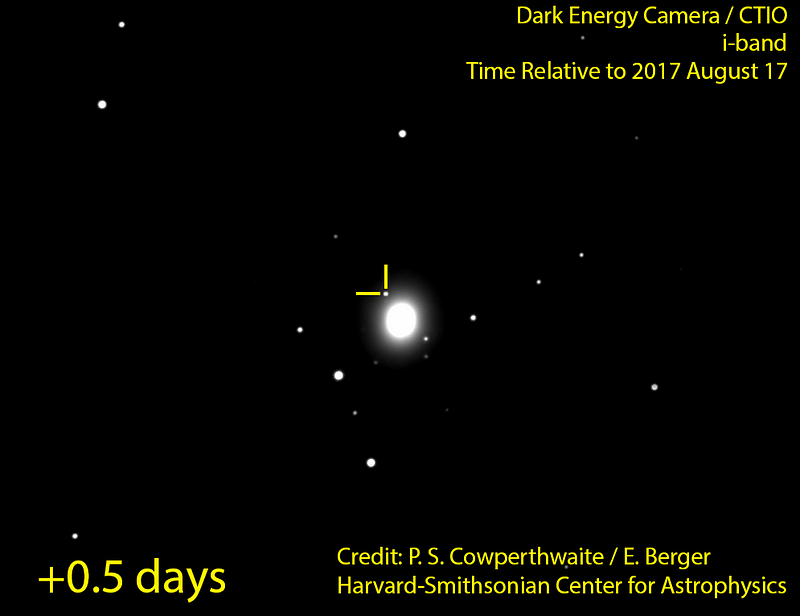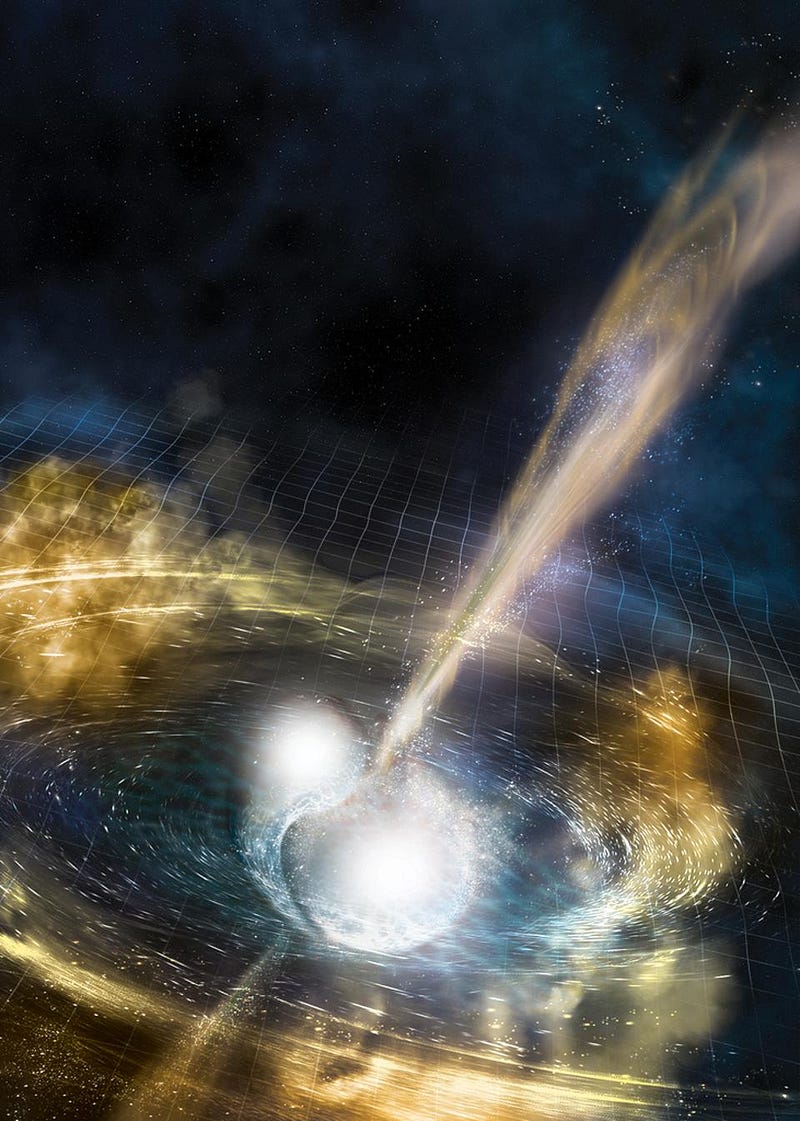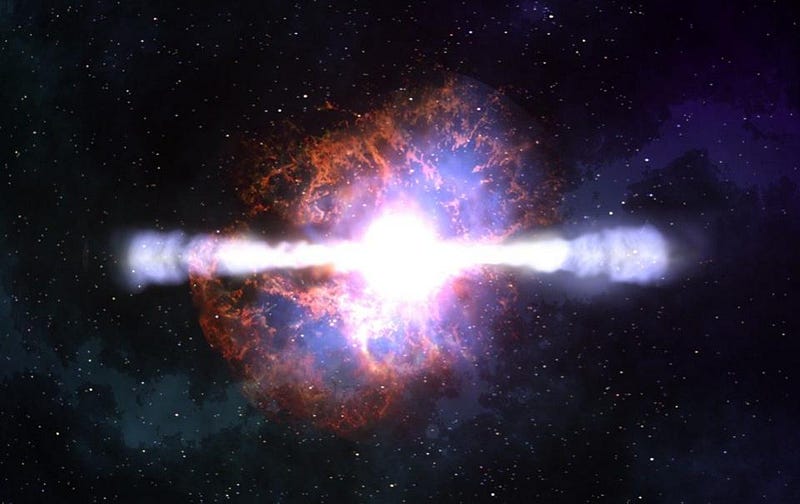Seeing One Example Of Merging Neutron Stars Raises Five Incredible Questions

Each discovery we make seems to raise even more questions. It’s a wonderful example of how science never ends.
On August 17th, both the light and the gravitational wave signals from inspiraling-and-merging neutron stars reached Earth, where both were detected, for the first time, by humans. The inspiral phase was seen for approximately 30 seconds in the LIGO and Virgo detectors, lasting more than 100 times as long as some of the earlier gravitational wave signals. This was the closest direct gravitational wave signal ever seen, at just 130 million light years away. While the observations gave rise to a tremendous suite of information, from a gamma-ray burst just 1.7 seconds after the merger to an optical and ultraviolet counterpart that lasted for days before fading away to a radio afterglow, a new challenge arises: making theoretical sense of it all.

I sat down with Chris Fryer of Los Alamos National Laboratory, a specialist in supernovae, neutron stars, and gamma ray bursts, who works on the theoretical side of these objects and events. There was very little expectation that LIGO and Virgo were going to see a merger at this early stage in the project, just two years after the first successful detection and well before reaching design sensitivity. Yet not only did they see it, they were able to use the data to pinpoint the precise location of the merger, resulting in the incredible multiwavelength follow-up that’s brought us so many surprises.
With so much information, much of it surprising, coming from the discovery, there are dozens of new papers out already trying to make sense of what we’ve seen. Here are the five biggest new questions the discovery raises.

1.) What is the rate at which neutron star-neutron star mergers occur? Before this event was observed, we had two ways of estimating how frequently two neutron stars would merge: from measurements of binary neutron stars in our galaxy (such as from pulsars), and from our theoretical models of star formation, supernovae, and their remnants. That gave us a mean estimate of around 100 such mergers every year within a cubic gigaparsec of space.
Thanks to the observation of this event, we now have our first observational rate estimate, and it’s about ten times larger than we expected. We thought we would need LIGO to reach its design sensitivity (it’s only halfway there) before seeing anything, and then on top of that we thought that pinpointing the location in at least 3 detectors would be unlikely. Yet we not only got it early, we localized it on the first try. So now the question is, did we just get lucky by seeing this one event, or is the true event rate really so much higher? And if it is, then what is it about our theoretical models that are so wrong? While LIGO spends the next year upgrading, theorists will have a little bit of time to try and figure out why.

2.) What causes so much matter to be ejected from a merger like this? Our best theoretical models predicted, for neutron star-neutron star mergers such as this, there would be a bright light signal in the ultraviolet and optical parts of the spectrum for about a day, and then it would dim and fade away. But instead, it lasted two days before beginning to dim, telling us that much, much more matter was ejected during this merger than we had anticipated. While this bright glow lasting so long indicates that perhaps 30 to 40 Jupiter-masses worth of material was blown off from the winds in a disk around these stars, the estimates from our best models ranged from half that to as little as an eighth of that figure.
So why are these wind ejecta so uncertain? In order to simulate such a merger, you need to incorporate a lot of different physics, including:
- hydrodynamics,
- general relativity,
- magnetic fields,
- the equation of state for matter at nuclear densities,
- the interactions with neutrinos,
and much more. Various codes model these components at varying levels of sophistication, and we are not entirely sure which component(s) are responsible for these winds and the ejecta. Getting this right is a challenge for theorists, and one we’ll have to rise to now that we’ve actually measured a neutron star-neutron star merger for the first time… and gotten quite a surprise.

3.) Did this merger produce a hypermassive neutron star? In order to get enough mass loss out of the neutron star merger, you need for the product of this merger to generate enough energy of the proper type to blow off this much matter from a surrounding disk. Based on the gravitational wave signal observed, this merger produced an object of 2.74 solar masses, which is significantly above the 2.5 solar mass maximum we expect for a non-rotating neutron star. That is to say, if nuclear matter behaves the way we expect it does, then even if the inspiral of the two neutron stars should have resulted in a black hole.

If the core of this object, post-merger, collapsed to a black hole immediately, though, there would be no ejecta! If, instead, it became a hypermassive neutron star, it should have been rotating extremely rapidly, as a large amount of angular momentum could raise that maximum mass limit by 10–15%. The problem? If we had a hypermassive neutron star spinning so rapidly, we’d expect that it would be a magnetar, with an incredibly strong magnetic field some quadrillion times stronger than the fields we have at the surface of the Earth. But magnetars lose their spin very quickly, and should collapse into a black hole in about 50 milliseconds, while the detailed calculations of the magnetic fields, viscosity, and heating that drives the wind ejecta indicates that hundreds of milliseconds are needed to reproduce these observations.
Something is fishy here. Either we have a rapidly rotating neutron star that, for some reason, is not a magnetar, or we had ejecta for hundreds of milliseconds and our physics doesn’t add up the way we think it should. No matter what, it’s likely that, at least for a time, we had a hypermassive neutron star, while it’s also likely that we have a black hole today. If both of these are true, it means this would be the most massive neutron star and the least massive black hole we’ve ever found!

4.) If these neutron stars had been more massive, would the merger have been invisible? There’s a limit to how massive neutron stars can be, as if you add more and more mass onto them, you go directly to a black hole. That ~2.5 solar mass limit for non-rotating neutron stars means that if the total mass of the merger is under that, you’ll almost certainly wind up with a neutron star after the merger, which should result in a stronger, longer ultraviolet and optical signal than what we saw with this event. On the other hand, if you get up above around 2.9 solar masses, then you should form a black hole immediately post-merger, with potentially no ultraviolet and optical counterpart.
Somehow, our very first neutron star-neutron star merger came right in this in-between range, where you can have a hypermassive neutron star that creates ejecta and an ultraviolet/optical signal for a short period of time. Do the lower-mass mergers wind up forming stable magnetars? Do the higher-mass ones go directly to black holes, and merge invisibly in these visible-ish wavelengths? And how rare or common are those three categories of merger products: normal neutron star, hypermassive neutron star, or direct black hole? After another year, LIGO and Virgo will start returning the answer, meaning theorists have only a year to get their simulations right to make better predictions.

5.) What causes gamma-ray bursts to be so bright in so many directions, not in a cone? This one’s a bit of a head-scratcher. On the one hand, this event confirmed what had long been suspected but never been proven: that merging neutron stars do, in fact, cause a short gamma ray burst. But what we had always expected was that gamma ray bursts would only emit gamma rays in a narrow cone-like shape, perhaps 10–15 degrees in diameter. Yet we know, from the orientation of the merger and the magnitude of the gravitational waves, that the gamma ray burst was off by about 30 degrees from our line-of-sight, yet we saw a significant gamma ray signal all the same.
The nature of what we know gamma ray bursts to be is changing. While future observations of merging neutron stars will help guide the way, the challenge for theorists is to explain why the physics of these objects is so different from what our models had predicted.

Bonus: How opaque/transparent are these heavy elements? When it comes to the heaviest elements in the periodic table, we know now that neutron star mergers are what generates the overwhelming majority of them: not supernovae. But to get the spectra of these heavy elements from over 100 million light years away, you also have to understand their opacities. This involves understanding the atomic physics transitions of the electrons in the atoms’ orbitals, and how that plays out in an astronomical setting. For the first time, we have an environment for testing the overlap of astronomy with atomic physics, and both follow-up observations and subsequent mergers should enable us to learn the answer to the opacity/transparency question, too.

It’s eminently possible that neutron star-neutron star mergers are happening all the time, and that when LIGO achieves its design sensitivity, we’ll find perhaps a dozen of them every year. But it’s also possible that this one event was an extreme rarity, and we’ll be lucky to see one of them per year, even after the current upgrade. We’ve already learned that neutron stars are very close to a point source (or the gravitational wave signal would deviate), that merging neutron stars indeed produce short gamma ray bursts, and that there’s lots of physics to work out to correctly model how these mergers work. Over the next decade, theorists and observers will strive to find the answers to these questions, and quite possibly, others that we aren’t informed enough to ask just yet.
The future of astronomy is upon us. Gravitational waves are now another, completely independent way to survey the sky, and by correlating the gravitational wave sky with traditional astronomy, we’re poised to answer questions that we didn’t even know we should be asking a week ago.
Ethan Siegel is the author of Beyond the Galaxy and Treknology. You can pre-order his third book, currently in development: the Encyclopaedia Cosmologica.




